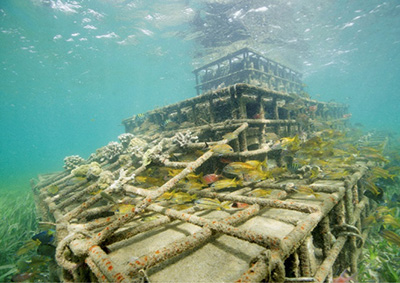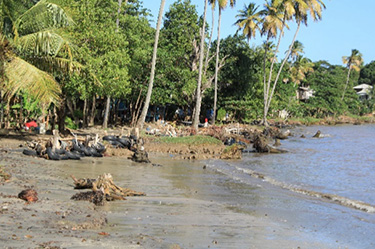The catastrophic 2017 hurricane season provided ample demonstrations of the increasing vulnerability of Caribbean populations and infrastructure to natural disasters. Researchers at UC Santa Cruz and the Nature Conservancy have now measured the protective role of coral reefs and field-tested a solution that reduces coastal risks by combining innovative engineering with restoration ecology.
Working in Grenville Bay, Grenada, the researchers showed that degradation of coral reefs is directly linked to shoreline erosion and coastal flooding in parts of the bay. The study, published February 1 in the Journal of Environmental Management, also evaluates one of the first uses of reef restoration as natural infrastructure specifically designed to reduce risks to people and property.
Investigating the link between healthy reefs and shoreline stability, the researchers found that Grenville’s healthy reefs keep more than half of the bay’s coastline intact by reducing the wave energy arriving on shore. In contrast, severe reef degradation is linked with chronic coastal erosion in the northern section of the bay, where the shoreline is disappearing at a rate of nearly two feet every year.
In an attempt to adapt, villagers have built makeshift barriers with tires and driftwood to slow the erosion threatening their homes, but these efforts have been largely unsuccessful. The reef restoration project was designed to enhance both the ecological functions of natural reef habitat and its protective effects.
“We are able to apply coastal engineering tools and models to support reef science and management. Ours is one of the first studies to directly show with evidence from the field sites and engineering models the impacts of reef loss on shorelines,” said lead author Borja Reguero, a researcher at the Institute of Marine Sciences at UC Santa Cruz.
Coastal resilience
The study was part of an innovative coral reef restoration project called At the Water's Edge (AWE), a community-based initiative led by the Nature Conservancy to increase coastal resilience to climate change. The researchers field-tested a reef-based breakwater structure that represents one of the few existing examples of reef restoration designed to increase community resilience and decrease vulnerability. The aim is to facilitate the recovery of the coral reef and to directly reduce coastal erosion and flooding. With support from the German Federal Foreign Office and in partnership with Grenada Fund for Conservation, Grenada Red Cross Society, and community members, the pilot reef-based breakwater structure was formally launched in early January 2015.
“Grenada has been at the front lines of climate change both in impacts and importantly as a leader among small islands and developing states in addressing these problems,” said AWE project lead Nealla Frederick.
The reef restoration structure is made from inexpensive and locally-sourced materials and labor, easy to assemble on-site, suitable for high wave energy or hurricane exposure, and specially designed to encourage habitat restoration and enhancement. Live coral fragments from the existing reef were placed onto the structure to encourage natural reef growth. This approach is designed to be replicated in small island communities, which are often the most susceptible to the impacts of climate change.
According to coauthor Michael Beck, lead marine scientist at the Nature Conservancy and research professor of ocean sciences at UC Santa Cruz, a growing body of scientific studies and project-based experience shows that coastal habitats such as coral reefs, oyster reefs, mangroves, wetlands, and dunes can offer cost-effective protection from the increasing impacts of climate change. This study builds on that knowledge, highlighting the potential and importance of prioritizing and investing in coastal habitats as effective and cost-effective natural infrastructure, he said. Island nations can meet their adaptation and hazard mitigation goals by investing in nature-based defenses, to significantly increase their coastal resilience and reduce the growing economic and human losses caused by coastal hazards.
“Reef degradation destroys the natural breakwaters for tropical coastlines in the United States and across more than 60 other nations. Our study identifies how severe this problem can be, and we used that information to design an innovative reef restoration solution to help people and nature,” Beck said.




